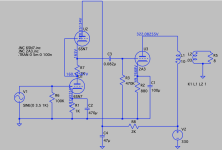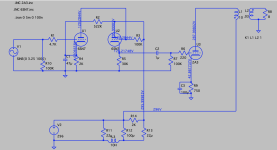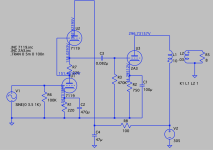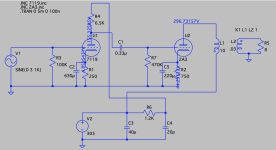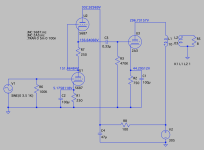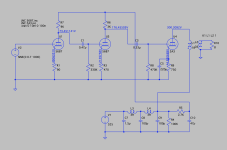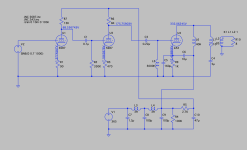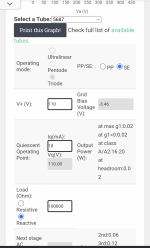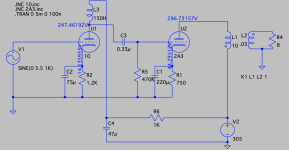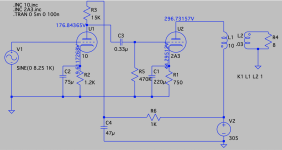100 ohm for the cathode resistor results in 0.268v cathode voltage, bypassed by a cap, you will have grid current with 1.25V peak input signal.
Yes, in LTSpice, the signal starts to distort after 1.25V of input.
What do you mean by "you will have grid current"? Is there an adverse condition that would result from the low (0.27V) cathode voltage?
Would it be better to go without a cathode bypass cap on the lower half? In LTSpice, removing the cap barely changes the gain.
I mean that the 6SL7 grid will be positive relatively to the cathode, therefore some grid current will flow, which usually results in distortion. You will be running that triode in class AB2. How much will it distort? I do not know.Yes, in LTSpice, the signal starts to distort after 1.25V of input.
What do you mean by "you will have grid current"? Is there an adverse condition that would result from the low (0.27V) cathode voltage?
Would it be better to go without a cathode bypass cap on the lower half? In LTSpice, removing the cap barely changes the gain.
Removing the cap should make it better, just plot the grid and cathode signals and make sure the grid is always equal or below the cathode voltage.
Also, your input signal comes from an ideal source, zero impedance. If you, for example put a volume potentiometer there, you probably will get in trouble with the grid current.
Thanks, yes that makes sense now.
Don't get me wrong, the 6SL7 in SRPP pushing 0.7mA sounds wonderful as-is. Maybe it's having slewing issues, maybe it's not -- I'd need to know how to check.
But if it's a technical requirement to get a 6SL7 producing up to 3mA (or even 2.5mA) of drive current in SRPP mode, then it doesn't seem to be possible to do that for a 2A3.
Getting 2mA of drive current from 6SL7 for a 45, however, is no problem.
It's possible to drive a 2A3 with a 6SN7 in SRPP (biased at 4.8mA in the attached screenshot). That leaves an input sensitivity of 3.5V and would require a preamp or an additional input stage. Might not be a bad option.
Anyway, I'm going to keep thinking about how to get enough drive current and lower impedance out of a 6SL7 -- cathode follower maybe?
Don't get me wrong, the 6SL7 in SRPP pushing 0.7mA sounds wonderful as-is. Maybe it's having slewing issues, maybe it's not -- I'd need to know how to check.
But if it's a technical requirement to get a 6SL7 producing up to 3mA (or even 2.5mA) of drive current in SRPP mode, then it doesn't seem to be possible to do that for a 2A3.
Getting 2mA of drive current from 6SL7 for a 45, however, is no problem.
It's possible to drive a 2A3 with a 6SN7 in SRPP (biased at 4.8mA in the attached screenshot). That leaves an input sensitivity of 3.5V and would require a preamp or an additional input stage. Might not be a bad option.
Anyway, I'm going to keep thinking about how to get enough drive current and lower impedance out of a 6SL7 -- cathode follower maybe?
Attachments
The 6SL7 would not be my choice for a driver. A 12AT7 can drive more current and has a similar gain. PC86s are very linear, 6N1Ps have less gain, but still can give 50V peak with less than 2Vpeak input. There are, IMHO, much better options than a 6SL7 out there.
On a 45 SET amplifier I built, ultimately settled on a (gyrator-loaded) 6N1P for the gain it provided and the bias point flexibility it offers.The 6SL7 would not be my choice for a driver. A 12AT7 can drive more current and has a similar gain. PC86s are very linear, 6N1Ps have less gain, but still can give 50V peak with less than 2Vpeak input. There are, IMHO, much better options than a 6SL7 out there.
You can use it for full amplification with a 1.4V RMS signal as well as a 2V RMS input. The 6N1P hit the "sweet spot" for full volume/output on every recording from my DAC streamer (2V RMS).
Am thinking I will eventually use a 6N1P on my personal 2A3 amplifier, as a single gyrator-loaded 6J5 isn't quite cutting it.
Jc above is writing about grid bias point--there are plenty of discussions here about it. Off the top of my head, Vinylsavor has posted a few times. Bias deep so you don't have to worry about the input signal bringing you close to or above the chosen bias voltage.
I've seen a number of people who built 6N1P line preamps, so I'll look into that tube. Thanks for the info.
Bud Purvine once suggested using "the pair of driver grids from a triode 7119 from Telefunken or Phillips to drive the 2A3." I'm not sure what he meant by that. I tried looking up 'vacuum tube grid drive' but didn't see anything that would apply here. Is there some other term for that, or does anyone know what he meant?
For the heck of it, I modeled a simple VA and SRPP versions of 7119 to drive the 2A3 in LTSpice. 7119 is a computer tube, but very linear, and designed to run at around 120V/36mA. The datasheets I've found do not list the plate resistance, but this site claims it is 1.6K, which is pretty low and might work well as a simple VA:
https://www.homecookingwithvalves.com/Vacuum-Tubes/Tube-Tables-and-Tube-Parameter-Values.html
Looking at the plate curves (datasheet attached), I figured 20mA would be above the elbows enough with 150V across the tube to operate in a very linear region. 20mA seems like overkill to drive the grid of the 2A3, but anyway screenshots are attached for the curious.
Perhaps a cathode-follower would work well with 7119 too.
However, I've already got a 6SN7 cathode follower stage in the mono blocks that drive my main system, so I'd prefer to try something else for the sake of experimentation. I reverse-engineered George Wright's WPA 3.5, a 2A3 SET, but am running a 300B instead (with MQ TFA-204 OPTs). The 6SN7 cathode follower stage puts 4.7mA into the 2A3 (300B) and it sounds great (screenshot attached).
The 7119 and 6SN7 have similar amplification factors -- 24 and 20 respectively -- so any way you configure them the input sensitivity is between 3.0-3.5V, meaning they need a line preamp or an additional input stage.
Bud Purvine once suggested using "the pair of driver grids from a triode 7119 from Telefunken or Phillips to drive the 2A3." I'm not sure what he meant by that. I tried looking up 'vacuum tube grid drive' but didn't see anything that would apply here. Is there some other term for that, or does anyone know what he meant?
For the heck of it, I modeled a simple VA and SRPP versions of 7119 to drive the 2A3 in LTSpice. 7119 is a computer tube, but very linear, and designed to run at around 120V/36mA. The datasheets I've found do not list the plate resistance, but this site claims it is 1.6K, which is pretty low and might work well as a simple VA:
https://www.homecookingwithvalves.com/Vacuum-Tubes/Tube-Tables-and-Tube-Parameter-Values.html
Looking at the plate curves (datasheet attached), I figured 20mA would be above the elbows enough with 150V across the tube to operate in a very linear region. 20mA seems like overkill to drive the grid of the 2A3, but anyway screenshots are attached for the curious.
Perhaps a cathode-follower would work well with 7119 too.
However, I've already got a 6SN7 cathode follower stage in the mono blocks that drive my main system, so I'd prefer to try something else for the sake of experimentation. I reverse-engineered George Wright's WPA 3.5, a 2A3 SET, but am running a 300B instead (with MQ TFA-204 OPTs). The 6SN7 cathode follower stage puts 4.7mA into the 2A3 (300B) and it sounds great (screenshot attached).
The 7119 and 6SN7 have similar amplification factors -- 24 and 20 respectively -- so any way you configure them the input sensitivity is between 3.0-3.5V, meaning they need a line preamp or an additional input stage.
Attachments
Top of p3 of the Rogers (Philips Data) shews mu & gm. rp is mu / gm or 1.6K for rp.The datasheets I've found do not list the plate resistance, but this site claims it is 1.6K
We used a lot of these circa 1960 in test equipment doing magnetic memory core research.
Makes a good audio tube too. 👍
Attachments
Russian 6E6P and 6E5P (triode strapped) are popular to drive 300Bs, thye could of course drive a 2A3 as well. Alex Moglia has plenty of info about those on his site.
https://www.bartola.co.uk/valves/2013/02/18/6e5p6э5п-and-6e6p-e6э6п-e-in-triode-mode/
https://www.bartola.co.uk/valves/2013/02/18/6e5p6э5п-and-6e6p-e6э6п-e-in-triode-mode/
OK, I read through Alex's stuff and couldn't resist. A pair of gold pin 6E6P-DRY is on its way now. Really looking forward to trying them.
andyjevans,
Nice circuit.
Using a resistor plate load is good for the right driver tube.
What output transformer make and model are you using?
Happy listening!
Nice circuit.
Using a resistor plate load is good for the right driver tube.
What output transformer make and model are you using?
Happy listening!
OPT is made by Techno in the UK. Nice but no longer available I'm afraid. PSU is big Hammond mains and choke and GZ34.
This isn't my daily amp - it's for sale from London UK. I'll have to list it here.
This isn't my daily amp - it's for sale from London UK. I'll have to list it here.
I like the pictures of that amp in the Swap Meet, Andy. Good luck with the sale.
I've typically found noval tubes to have an underwhelming performance as power amp inputs/drivers, especially the 5842/417A (see previous post where I tried it here). But now that I'm considering 6E6P and 7119, I might as well try 6N1P and some others, so I'm adding them to the list.
I came across Jean-François Lessard's Horus 2A3 circuit a few years ago, a parafeed design which uses 5687 for two voltage amps in series. The datasheet reveals 5687 to be a very linear tube with plate current in the range of 12-36mA during typical A1 operation, and plate resistance of 2K-3K in the operating range we'd be considering. It is also characterized by high perveance and high emission capabilities. My limited understanding of perveance is that it essentially refers to the amount of current a tube can handle, but I don't know how perveance might factor into audio circuit design.
Anyway, attached here are three quick 5687-2A3 designs in the following order: Lessard's original Horus, a non-parafeed version of it, and an SRPP version. I tried doing a cathode follower but it doesn't seem possible to get the required 120VDC or so on the 5687 cathode to drive the 2A3 grid. Operating voltages shown in the attached screenshots.
The VA designs would work well as integrated amps while the SRPP would of course need a line preamp in front of it -- not the worst thing.
I dunno, does 15-20mA driving the 2A3 grid seem like overkill?
I've typically found noval tubes to have an underwhelming performance as power amp inputs/drivers, especially the 5842/417A (see previous post where I tried it here). But now that I'm considering 6E6P and 7119, I might as well try 6N1P and some others, so I'm adding them to the list.
I came across Jean-François Lessard's Horus 2A3 circuit a few years ago, a parafeed design which uses 5687 for two voltage amps in series. The datasheet reveals 5687 to be a very linear tube with plate current in the range of 12-36mA during typical A1 operation, and plate resistance of 2K-3K in the operating range we'd be considering. It is also characterized by high perveance and high emission capabilities. My limited understanding of perveance is that it essentially refers to the amount of current a tube can handle, but I don't know how perveance might factor into audio circuit design.
Anyway, attached here are three quick 5687-2A3 designs in the following order: Lessard's original Horus, a non-parafeed version of it, and an SRPP version. I tried doing a cathode follower but it doesn't seem possible to get the required 120VDC or so on the 5687 cathode to drive the 2A3 grid. Operating voltages shown in the attached screenshots.
- Horus: 5687 @15mA ea., input sensitivity 0.7V
- Traditional VA-VA: 5687 @16mA ea., input sensitivity 0.7V
- SRPP: 5687 @146V/20mA ea., input sensitivity 3.5V
The VA designs would work well as integrated amps while the SRPP would of course need a line preamp in front of it -- not the worst thing.
I dunno, does 15-20mA driving the 2A3 grid seem like overkill?
Attachments
Last edited:
"Overkill"? Am not an expert, but this does not seem like something to be worrying about.
Very subjective experience, but I found that when I tried the 5687 gyrator-loaded at the operating point shown below, it was my least favorite among E180F, 6N1P, 6N6P, 6Z51P, and 6J5. I hesitate to say anything specific since everyone should listen to every possible combination of components and decide for themselves, but my 5687 -> 45 amp sounded "hard" and was not pleasant.
Like you started out doing, you should really consider prototyping the circuit and listening. For me at least, it's the only way I can make a decision and "just enjoy the music" afterward.
Attached image is from vtadiy.com.
Very subjective experience, but I found that when I tried the 5687 gyrator-loaded at the operating point shown below, it was my least favorite among E180F, 6N1P, 6N6P, 6Z51P, and 6J5. I hesitate to say anything specific since everyone should listen to every possible combination of components and decide for themselves, but my 5687 -> 45 amp sounded "hard" and was not pleasant.
Like you started out doing, you should really consider prototyping the circuit and listening. For me at least, it's the only way I can make a decision and "just enjoy the music" afterward.
Attached image is from vtadiy.com.
Attachments
I think the true answer to "how best to drive a 2a3" is to start with a 1:4 SUT on the input. My whole concept of a 2 stage design changed when I bought a pair of Hammond 1140-LN-C, their broadcast series and good devices well priced. With this I was able to take my pick of DHTs - 26, 4P1L, 2P29L, 112A, 10Y..... I settled on the 10Y and it's marvellous, best amp I've ever made. The 10Y isn't cheap these days though it's the best DHT I know of as a driver. But the very cheap and available 2P29L is going to sound better than all these medium mu 9 pin tubes. Better than a 6SN7 too. Example shown. Filament bias is the way to go here.
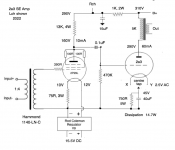

Yes, for sure. Work is very busy right now, so I'm trying to learn and think through some models to increase my understanding before I try more things out on the breadboard.Like you started out doing, you should really consider prototyping the circuit and listening. For me at least, it's the only way I can make a decision and "just enjoy the music" afterward.
Andy, if you don't mind my asking, at what operating points did you operate the 10Y? Seems it would need more supply voltage than the 2A3!
With the 10Y my preference is filament bias and a resistor load, and that ends up being a fairly low current operating point. That's unusual but it sounds nice to me. There are other choices like a good plate choke, an interstage or an active load. I just prefer a resistor. I've tried all the alternatives. OPTs are NP Acoustics amorphous core.
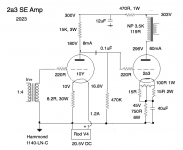

Interesting. Thank you, Andy. I’m working on a 26 line preamp with output transformers, which might be good in front of this. .
Do you connect the 10Y-2A3 amp directly to source, or is there a preamp?
Do you connect the 10Y-2A3 amp directly to source, or is there a preamp?
I just use a 2 stage amp. 1:4 SUT > 10Y > 2a3. The DAC goes straight in and volume is in software on my Mac.
You can do the same with the 26. You don't need the output transformers. I've tried the 26 instead of the 10Y but I prefer the 10Y - more inner detail and more neutral. The 26 is a bit warm for me. Much cheaper, though. The 1:4 SUT makes all-DHT amps possible and definitely sounds better than 3 stages to my ears. I like the Hammond 1140-LN-C, broadcast quality.
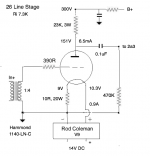
You can do the same with the 26. You don't need the output transformers. I've tried the 26 instead of the 10Y but I prefer the 10Y - more inner detail and more neutral. The 26 is a bit warm for me. Much cheaper, though. The 1:4 SUT makes all-DHT amps possible and definitely sounds better than 3 stages to my ears. I like the Hammond 1140-LN-C, broadcast quality.

Thank you Andy. Lots of new (to me) ideas here, and I appreciate meandering off the well-trod path.
Andy, in the 2A3-10Y schematic, are you sure the 10Y cathode resistor isn't something more like 1.2K instead of 8.2R? To get 8mA from 10V you'd need 10/0.008 = 1,250. Or perhaps the value of 8.2R is related to the Coleman regulator?
If I put the 8.2R resistor in LTSpice the cathode is at 98mV/12mA. With 1.25K it's close to the op point you posted, with about 8.25V input sensitivity.
For the heck of it, I replaced the 15K plate load resistor with a choke (150H and 3.75K DCR), and the 10Y is operating at 233V/12mA, which is closer to the manufacturer's lowest published op point of 250V/10mA, and about 5.5V input sensitivity.
I'll keep playing with this idea but... uhhh... I just searched eBay for 10Y tubes and, boy howdy....
Price aside, it would cost nearly all my domestic capital to get those past my bride...
Andy, in the 2A3-10Y schematic, are you sure the 10Y cathode resistor isn't something more like 1.2K instead of 8.2R? To get 8mA from 10V you'd need 10/0.008 = 1,250. Or perhaps the value of 8.2R is related to the Coleman regulator?
If I put the 8.2R resistor in LTSpice the cathode is at 98mV/12mA. With 1.25K it's close to the op point you posted, with about 8.25V input sensitivity.
For the heck of it, I replaced the 15K plate load resistor with a choke (150H and 3.75K DCR), and the 10Y is operating at 233V/12mA, which is closer to the manufacturer's lowest published op point of 250V/10mA, and about 5.5V input sensitivity.
I'll keep playing with this idea but... uhhh... I just searched eBay for 10Y tubes and, boy howdy....
Price aside, it would cost nearly all my domestic capital to get those past my bride...
Attachments
Last edited:
- Home
- Amplifiers
- Tubes / Valves
- Developing a 2A3 SET
